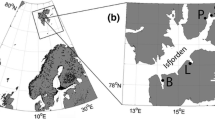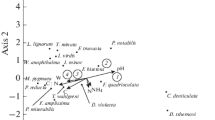Summary
The rhizosphere microarthropod fauna of a woody, deep-rooted legume, Prosopis glandulosa, was sampled at four sites in the northern Chihuahuan Desert and compared with the rhizosphere microarthropod fauna of a co-dominant shrub, Larrea tridentata. Prostigmatid mites (Speleorchestes sp.,Neognathus sp., Rhagidia sp., Tydaeolus sp., Steneotarsonemus sp., Tarsonemus sp., Nanorchestes sp., Gordialycus sp.), the cryptostigmatid mites (Bankisonoma ovata and Passalozetes neomexicanus), the mesostigmatid (Protogamasellus mica), and the collembolan (Brachystomella arida) characterized the fauna at depths greater than 1 m. Microarthropods were recovered from soils at a depth of 13 m at the edge of a dry lake and at depths of 7 m in a dry wash which were pre-European man P. glandulosa habitats. In habitats where P. glandulosa is a recent invader, root depth and microarthropods were less than 3 m. In most habitats, population densites of microarthropods at depths 0.5 m were more than 100 times those at depths ≫ 0.5 m. Population densities of microarthropods associated with P. glandulosa growing at the edge of a dry wash were not significantly smaller at 0.5−1.0 m depth than at 0−0.5 m. The deep-rhizosphere microarthropod fauna is a reduced subset of the fauna of surficial soils, suggesting that this fauna plays a role in decomposition and mineralization processes functionally similar to that of microarthropods in surficial soils.
Similar content being viewed by others
References
Buffington LC, Herbel CH (1965) Vegetational changes on a semidesert grassland range from 1858 to 1963. Ecol Monogr 35:139–164
Cannon WA (1925) Physiological features of roots with special reference to the relation of roots to aeration of the soil. Carnegie Institute of Washington, Publ No 368
Edwards CA, Fletcher KE (1971) A comparison of extraction methods for terrestrial arthropods. In: Phillipson J (ed) Methods of study in quantitative soil ecology: Population, production and energy flow. Blackwell, Oxford, pp 150–185
Fisher CE (1977) Mesquite and modern man in Southwestern America. In: Simpson BB (ed) Mesquite: Its biology in two desert ecosystems. Dowden, Hutchison and Russ, Stroudsville, Penn, pp 177–188
Freckman DW, Virginia RA (1989) Plant-feeding nematodes in deep-rooting desert ecosystems. Ecology (in press)
Henessey JT, Gibbins RP, Tromble JM, Cardenas M (1983) Vegetation changes from 1935 to 1980 in mesquite dunelands and former grasslands of southern New Mexico. J Range Manage 36:370–374
Kamill BW, Steinberger Y, Whitford WG (1985) Soil microarthropods from the Chihuahuan Desert of New Mexico. J Zool (Lond) 205:273–286
Parker LW, Santos PF, Phillips J, Whitford WG (1984) Carbon and nitrogen dynamics during the decomposition of litter and roots of a Chihuahuan Desert annual, Lepidium lasiocarpum. Ecol Monogr 54:339–360
Phillips WS (1963) Depth of roots in soil. Ecology 44:424
Santos PF, Whitford WG (1981) The effects of microarthropods on litter decomposition in a Chihuahuan Desert ecosystem. Ecology 62:654–663
Santos PF, DePree E, Whitford WG (1978) Spatial distribution of litter and microarthropods in a Chihuahuan Desert ecosystem. J Arid Environ 1:41–48
Santos PF, Philips J, Whitford WG (1981) The role of mites and nematodes in early stages of buried litter decomposition in a desert. Ecology 62:664–669
Simpson BB, Solbrig OT (1977) Introduction. In: Simpson BB (ed) Mesquite: Its biology in two desert ecosystems. Dowden, Hutchison and Russ, Stroudsville, Penn, pp 1–25
Steinberger Y, Whitford WG (1984) Spatial and temporal relationships of soil microarthropods on a desert watershed. Pedobiologia 26:275–284
Virginia RA, Jarrell WM (1987) Approaches for studying the function of deep root systems. In: Tenhunen JD, Catarino FM, Lange OL, Oechel WC (eds) Plant response to stress. NATO ASI Series Vol G15, Springer, Berlin Heidelberg, pp 107–127
Wallwork JAB, Kamill W, Whitford WG (1985) Distribution and diversity patterns of soil mites in a Chihuahuan Desert site. J Arid Environ 9:215–231
Walter DE (1987) Trophic behavior of “mycophagous” microarthropods. Ecology 68:226–229
Whitford WG, Steinberger Y, MacKay W, Parker LW, Freckman D, Wallwork JA, Weems D (1986) Rainfall and decomposition in the Chihuahuan Desert. Oecologia 68:512–515
Author information
Authors and Affiliations
Rights and permissions
About this article
Cite this article
Silva, S., Whitford, W.G., Jarrell, W.M. et al. The microarthropod fauna associated with a deep rooted legume, Prosopis glandulosa, in the Chihuahuan Desert. Biol Fert Soils 7, 330–335 (1989). https://doi.org/10.1007/BF00257828
Received:
Issue Date:
DOI: https://doi.org/10.1007/BF00257828




